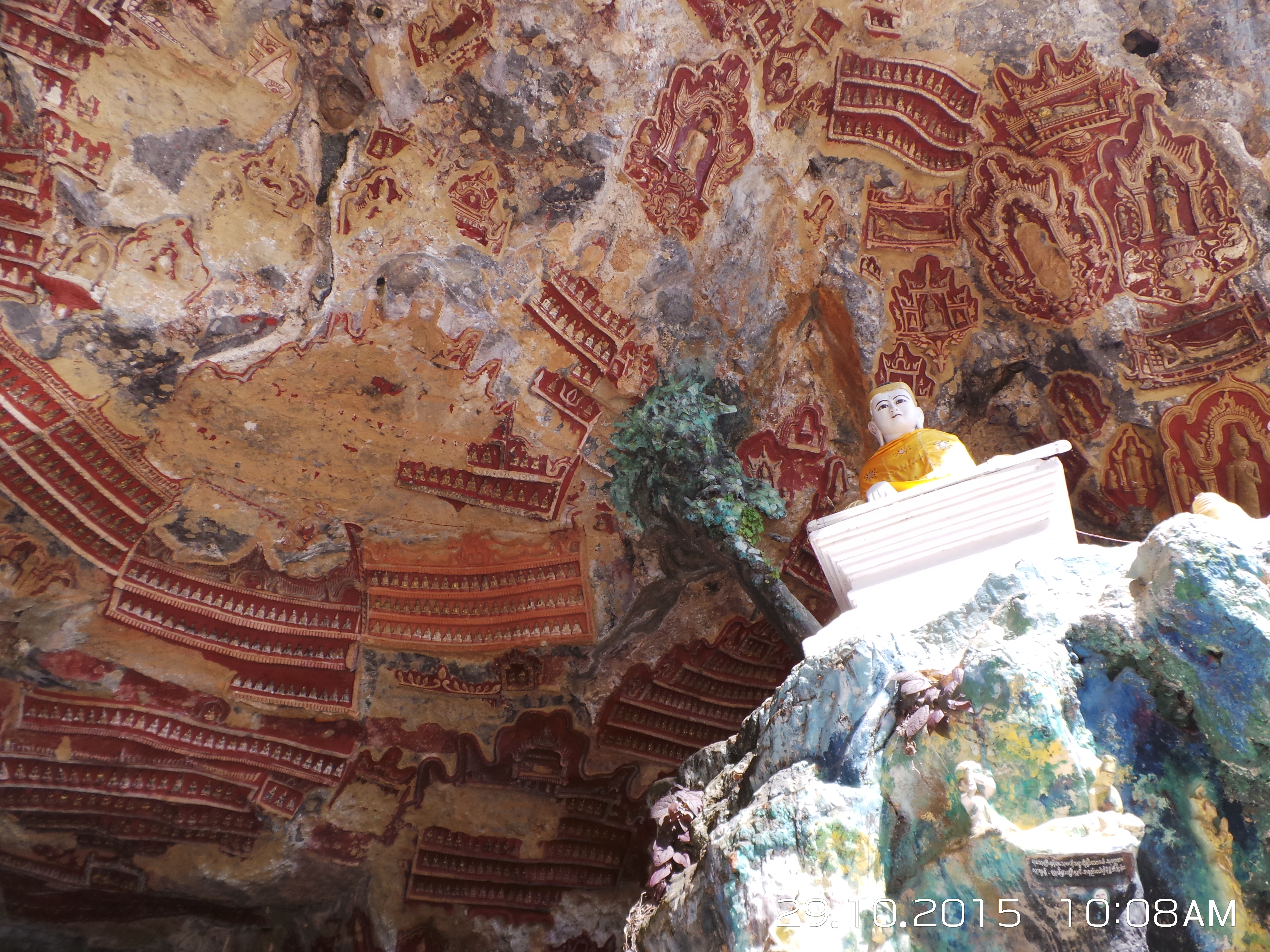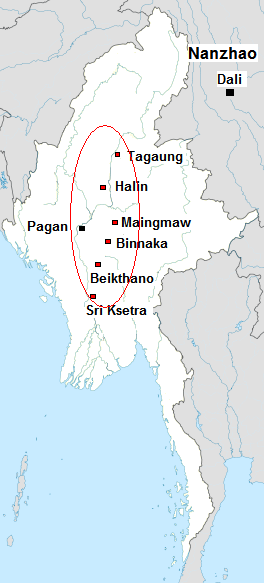|
Kawtgon Cave
The Kawgun Cave (Mon) ထီုကအ်ဂေါန် ( my, ကော့ဂွန်းဂူ; also spelt Kawgon Cave or Kawgoon Cave) is a Buddhist cave temple, located in , Hpa-An, Kayin State, Myanmar. The cave is lined with thousands of small Buddha statues covering its walls. The cave is an important historical and cultural heritage site in Myanmar. The rear of the cave leads to a row of floating restaurants in the Ruby Lake. Location The Kawgun Cave is located eight miles from Hpa-an, 28 miles from Mawlamyine, and two miles from the west bank of Thanlwin River. Located at the foot of Mt. Kawgun, the cave is 130 feet long, 70 feet wide, and 25 feet high. Mt. Kawgun is 60,000 feet long from northeast to southwest, and the highest point is 10,000 feet high. History The Kawgun Cave is a limestone cave. The origins of the cave temple are not clear. It is believed to have been constructed around the 7th century, but historian Nai Maung Toe has speculated, on the basis of i ... [...More Info...] [...Related Items...] OR: [Wikipedia] [Google] [Baidu] |
Shiva
Shiva (; sa, शिव, lit=The Auspicious One, Śiva ), also known as Mahadeva (; ɐɦaːd̪eːʋɐ, or Hara, is one of the principal deities of Hinduism. He is the Supreme Being in Shaivism, one of the major traditions within Hinduism. Shiva is known as "The Destroyer" within the Trimurti, the Hindu trinity which also includes Brahma and Vishnu. In the Shaivite tradition, Shiva is the Supreme Lord who creates, protects and transforms the universe. In the goddess-oriented Shakta tradition, the Supreme Goddess ( Devi) is regarded as the energy and creative power (Shakti) and the equal complementary partner of Shiva. Shiva is one of the five equivalent deities in Panchayatana puja of the Smarta tradition of Hinduism. Shiva has many aspects, benevolent as well as fearsome. In benevolent aspects, he is depicted as an omniscient Yogi who lives an ascetic life on Mount Kailash as well as a householder with his wife Parvati and his three children, Ganesha, Ka ... [...More Info...] [...Related Items...] OR: [Wikipedia] [Google] [Baidu] |
Manuha
Manuha ( my, မနူဟာ; mnw, မကုတရာဇာ; Old Mon ), or Makuta, was the last king of Thaton Kingdom. Manuha ruled Thaton from 1030s until 1057 when he was defeated by King Anawrahta of Pagan Kingdom. According to the Mon tradition, Manuha was the 59th in the line of kings who supposedly founded Thaton during the time of the Buddha in the 6th century BCE. Traditional Burmese and Mon reconstructions also hold that Anawrahta, a recent convert to Theravada Buddhism, asked for the Theravada Buddhist canon from Manuha. The Mon king reputedly rejected Anawrahta's request, saying that the uncultured Burmans of the north were not worthy of the religion. This refusal was used by Anawrahta as pretense to invade and conquer the Mon kingdom.Htin Aung 1967: 32–33 Despite this account, it is more likely Anawrahta conquered Thaton in order to check the westward advance of Khmer Empire in the Tenasserim coast. Still according to traditional belief, Manuha and his famil ... [...More Info...] [...Related Items...] OR: [Wikipedia] [Google] [Baidu] |
Thaton Kingdom
The Thaton Kingdom, Suwarnabhumi, or Thuwunnabumi ( my, သထုံခေတ် or ) was a Mon kingdom, believed to have existed in Lower Burma from at least the 4th century BC to the middle of the 11th century AD. One of many Mon kingdoms that existed in modern-day Lower Burma and Thailand, the kingdom was essentially a city-state centered on the city of Thaton. It traded directly with South India and Sri Lanka, and became a primary center of Theravada Buddhism in South-East Asia. Thaton, like other Mon kingdoms, faced the gradual encroachment of the Khmer Empire. But it was the Pagan Kingdom from the north that conquered the fabled kingdom in 1057. Name of the kingdom Mon tradition maintains that the kingdom was called Suvannabhumi ( my, သုဝဏ္ဏဘူမိ), a name also claimed by Lower Thailand, and that it was founded during the time of the Buddha in the 6th century BCE. Thaton is the Burmese name of Sadhuim in Mon, which in turn is from Sudhammapur ... [...More Info...] [...Related Items...] OR: [Wikipedia] [Google] [Baidu] |
Pagan Kingdom
The Kingdom of Pagan ( my, ပုဂံခေတ်, , ; also known as the Pagan Dynasty and the Pagan Empire; also the Bagan Dynasty or Bagan Empire) was the first Burmese kingdom to unify the regions that would later constitute modern-day Myanmar. Pagan's 250-year rule over the Irrawaddy valley and its periphery laid the foundation for the ascent of Burmese language and culture, the spread of Bamar ethnicity in Upper Myanmar, and the growth of Theravada Buddhism in Myanmar and in mainland Southeast Asia.Lieberman 2003: 88–123 The kingdom grew out of a small 9th-century settlement at Pagan (present-day Bagan) by the Mranma/Burmans, who had recently entered the Irrawaddy valley from the Kingdom of Nanzhao. Over the next two hundred years, the small principality gradually grew to absorb its surrounding regions until the 1050s and 1060s when King Anawrahta founded the Pagan Empire, for the first time unifying under one polity the Irrawaddy valley and its periphery. By t ... [...More Info...] [...Related Items...] OR: [Wikipedia] [Google] [Baidu] |
Anawrahta
Anawrahta Minsaw ( my, အနော်ရထာ မင်းစော, ; 11 May 1014 – 11 April 1077) was the founder of the Pagan Empire. Considered the father of the Burmese nation, Anawrahta turned a small principality in the dry zone of Upper Burma into the first Burmese Empire that formed the basis of modern-day Burma (Myanmar).Harvey 1925: 34Htin Aung 1967: 38 Historically verifiable Burmese history begins with his accession to the Pagan throne in 1044.Coedès 1968: 133, 148–149, 155 Anawrahta unified the entire Irrawaddy valley for the first time in history, and placed peripheral regions such as the Shan States and Arakan (Rakhine) under Pagan's suzerainty. He successfully stopped the advance of Khmer Empire into Tenasserim coastline and into Upper Menam valley, making Pagan one of two main kingdoms in mainland Southeast Asia. A strict disciplinarian, Anawrahta implemented a series of key social, religious and economic reforms that would have a lasting impa ... [...More Info...] [...Related Items...] OR: [Wikipedia] [Google] [Baidu] |
Mottama
Mottama ( my, မုတ္တမမြို့, ; Muttama mnw, မုဟ်တၟံ, ; formerly Martaban) is a town in the Thaton District of Mon State, Myanmar. Located on the west bank of the Thanlwin river (Salween), on the opposite side of Mawlamyaing, Mottama was the capital of the Martaban Kingdom (later known as Hanthawaddy Kingdom) from 1287 to 1364, and an entrepôt of international repute until the mid-16th century. Etymology "Mottama" derives from the Mon language term "Mumaw" ( mnw, မုဟ်တၟံ; ), which means "rocky spur." History Prior to 15th century From the 2nd century BCE to the 15th century CE, Martaban was an important trading port. The historic Maritime Silk Road connected the East and West, and Martaban storage jars were imported through this trade route. The earliest evidence of the existence of Martaban in Myanmar history was revealed in an inscription erected by King Sithu II of the Bagan Empire in 1176. The ancient city was call ... [...More Info...] [...Related Items...] OR: [Wikipedia] [Google] [Baidu] |
Ganesh
Ganesha ( sa, गणेश, ), also known as Ganapati, Vinayaka, and Pillaiyar, is one of the best-known and most worshipped deities in the Hindu pantheon and is the Supreme God in Ganapatya sect. His image is found throughout India. Hindu denominations worship him regardless of affiliations. Devotion to Ganesha is widely diffused and extends to Jains and Buddhists and includes Nepal, Sri Lanka, Thailand, Indonesia ( Java and Bali), Singapore, Malaysia, Philippines, and Bangladesh and in countries with large ethnic Indian populations including Fiji, Guyana, Mauritius, and Trinidad and Tobago. Although Ganesha has many attributes, he is readily identified by his elephant head. He is widely revered, more specifically, as the remover of obstacles and thought to bring good luck; the patron of arts and sciences; and the deva of intellect and wisdom. As the god of beginnings, he is honoured at the start of rites and ceremonies. Ganesha is also invoked as a patron of letter ... [...More Info...] [...Related Items...] OR: [Wikipedia] [Google] [Baidu] |
Vishnu
Vishnu ( ; , ), also known as Narayana and Hari, is one of the principal deities of Hinduism. He is the supreme being within Vaishnavism, one of the major traditions within contemporary Hinduism. Vishnu is known as "The Preserver" within the Trimurti, the triple deity of supreme divinity that includes Brahma and Shiva. Gavin Flood, An Introduction to Hinduism' (1996), p. 17. In Vaishnavism, Vishnu is the supreme being who creates, protects, and transforms the universe. In the Shaktism tradition, the Goddess, or Adi Shakti, is described as the supreme Para Brahman, yet Vishnu is revered along with Shiva and Brahma. Tridevi is stated to be the energy and creative power ( Shakti) of each, with Lakshmi being the equal complementary partner of Vishnu. He is one of the five equivalent deities in Panchayatana puja of the Smarta tradition of Hinduism. According to Vaishnavism, the highest form of Ishvara is with qualities ( Saguna), and have certain form, but is limit ... [...More Info...] [...Related Items...] OR: [Wikipedia] [Google] [Baidu] |


